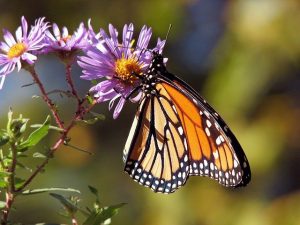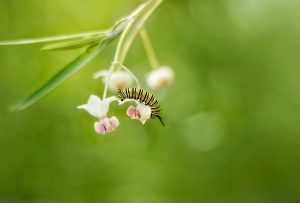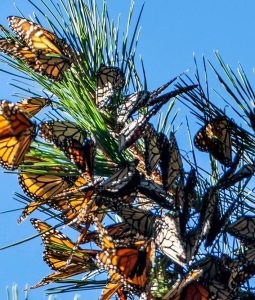Monarch butteries, an American icon, are in danger!
Worldwide Monarch Butterfly population is experiencing a significant decline – especially in the Western US – from 10 million to just 2,000 from the the 1980s to 2021, (1)
 Typical Monarch migration pattern is winter in Mexico and flying north to make homes in the Western half of USA and across the continent in Spring. They detect seasonal weather changes to alert them when to begin their thousand mile journeys. Butterflies are only one of more than a dozen insects that pollinate flowers and plants so new ones can grow.
Typical Monarch migration pattern is winter in Mexico and flying north to make homes in the Western half of USA and across the continent in Spring. They detect seasonal weather changes to alert them when to begin their thousand mile journeys. Butterflies are only one of more than a dozen insects that pollinate flowers and plants so new ones can grow.
Habitat Loss
Climate change, storms, drought and loss of habitat from forest clearing has led to changing seasonal migratory patterns, and fewer overwintering sites where they live protected from cold temperatures.
Pesticide and Herbicides
 Butterflies look for Milkweed plants to lay their eggs because Monarch caterpillars dine exclusively on the Milkweed plant. Continued use of chemicals threatens these life-giving plants the caterpillars need to live.. Forest clearing to make way for agriculture and housing has also reduced the amount of areas where Milkweed is grown.
Butterflies look for Milkweed plants to lay their eggs because Monarch caterpillars dine exclusively on the Milkweed plant. Continued use of chemicals threatens these life-giving plants the caterpillars need to live.. Forest clearing to make way for agriculture and housing has also reduced the amount of areas where Milkweed is grown.
How You Can Help!
 Create your own pollinator garden to attract butterflies (and other pollinators) at your home, school or site. These gardens attract a diverse range of species, ranging from butterflies to hummingbirds, bees and many, many more.
Create your own pollinator garden to attract butterflies (and other pollinators) at your home, school or site. These gardens attract a diverse range of species, ranging from butterflies to hummingbirds, bees and many, many more.
Visit website links below. Selections from dozens of online resources to learn more about Monarch butterflies and what actions you can take to help save the species.
References
Why Monarch Butterflies, now endangered, are on the “edge of collapse.” Washington Post, July 21, 2022. Diro Grandoni. (1)
North American Monarch Butterfly Monitoring Network.